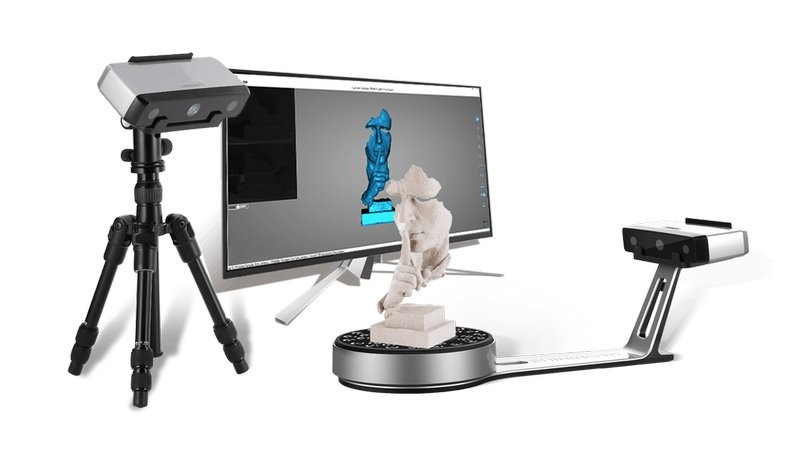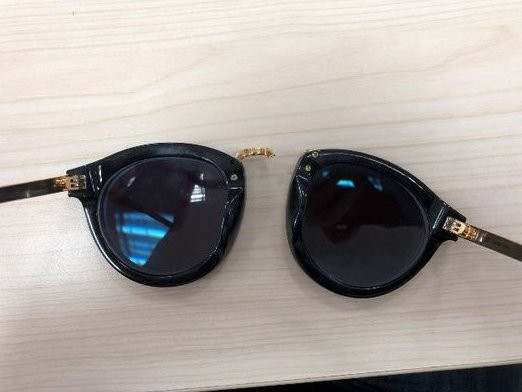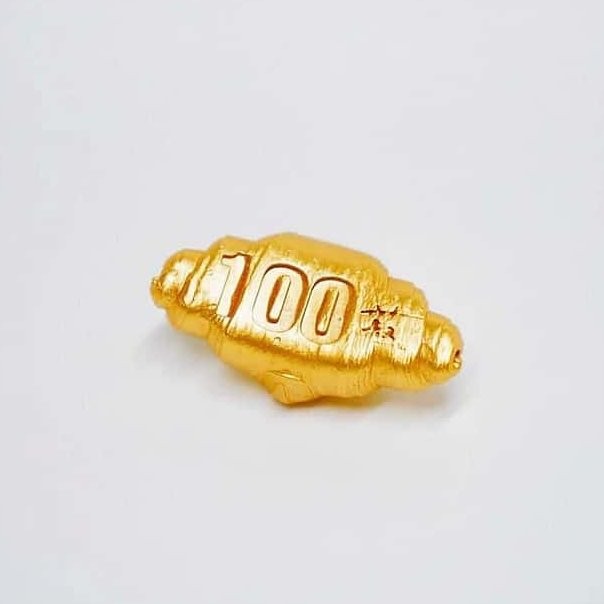
Hey everyone! This is Top 3D Shop, and in the following review, we will tell you about the Shining 3D Einscan-SP 3D scanner — a highly accurate, professional device for product design, reverse engineering, modeling, and other applications. Read on to learn about its specs and features; be sure to check out some case studies as well.

Credit: einscan.com
Shining 3D has been developing 3D equipment since 2004. The company specializes in the development, production, and sales of scanners, printers, and corresponding materials. The manufacturer's goal is to make 3D technology available not only to large corporations but also the consumer market. Shining 3D scanners and printers are used in design and industrial production, medicine, art, science, and education.
Shining 3D is the first company to create a cloud-based platform for its customers to remotely access and share their stored designs.
The company is one of the market leaders in the additive technology segment in China. This is evidenced by the high quality of their products, growing sales volume, and customer-oriented service support.
Shining 3D is headquartered in China, with subsidiaries in Germany and the United States. Its products are used by representatives of over 70 countries.
The Shining 3D Einscan-SP can be viewed as an upgraded model of the Einscan-SE scanner. They are similar in design and operation principle, but have a number of differences. The cost for the SP is almost twice as high as that of the SE model, yet the accuracy and scanning speed doubled as well. It is noteworthy that the novelties did not affect the ease of use — the Einscan-SP is suitable for technically untrained users as well.
On the front side of the scanner, there are two 1.3-megapixel cameras with a projector lens that illuminates the object during scanning. The device uses eye-safe white light as its light source. It features two scanning modes: Fixed Scan (that is, manual) and Auto Scan.
The Auto Scan mode is only suitable for objects of up to 5 kg. The length of the longest side should not exceed 25 cm. This mode is meant for scanning light matte objects with simple geometry. To scan shiny, translucent, and dark objects, it is recommended to apply a matte spray before the process.
In this mode, the object is placed on a turntable with markers and is automatically rotated while the scanner takes pictures.

Credit: einscan.com
Manual mode is recommended for objects heavier than 5 kg, with length more than 25 cm, and items with complex geometry. In this case the scanner is set on a tripod, and the object to be scanned is placed on a flat surface. The object is rotated manually.

The 3D scanner comes with the following set of equipment:
For some items, package content may change. In case of any questions, please get in touch.
The Shining 3D Einscan-SP comes unassembled in a reliable box. It takes no more than ten minutes to assemble the device. The turntable is inserted in one part of the stand; the holder for the scanner itself is screwed into the other end. Next, the scanner is connected to the turntable with a cord, and then via a USB port to a laptop or desktop computer and to an electrical outlet.

First off, the scanner is to be calibrated. For this purpose, the calibration board should be fixed on the stand and placed on the turntable. The process is performed in a semi-automatic mode: the user's task is to follow the instructions on the computer monitor. For texture scanning, it is also necessary to adjust the white balance.

Credit: einscan.com
The scanner comes with the proprietary Einscan-S software, which offers a plethora of functions. These include combining scans (manually or automatically), selecting the type of a digital model, sending it to print or saving the project for further processing.

Credit: einscan.com
The Shining 3D Einscan-SP was utilized to repair sunglasses. One user scanned the undamaged half of the "bridge" and performed reverse engineering to repair the broken part.

Credit: einscan.com
The shiny part required applying a matting spray before scanning.

Credit: einscan.com

Credit: einscan.com
The user then created a digital model of the one-piece part and printed a new "bridge" for the glasses on a 3D printer.

Credit: einscan.com
The owner of a small bakery from Suzhou decided to make a coupon in the form of a small plastic bread. She couldn't find a 3D model on the web, so she used a Shining 3D Einscan-SP and a 3D printer. Small pastry was scanned in automatic mode.

Credit: einscan.com
Scanning a long baguette required the use of manual mode.
The digital models were then finalized, printed, and painted.

Credit: einscan.com
Visitors to the bakery appreciated the plastic mini-pastry made with 3D technology.

Credit: einscan.com
An art installation with butterflies was made by Atelier INDJ using 3D technology: the Einscan-SP scanner with a Discovery Pack add-on for scanning butterflies. The manual scanning mode using a turntable as a stand made it quick and easy to scan objects, while the 12-megapixel Discovery Pack cameras captured the rich color and detail of the butterflies. The entire process of 3D scanning and creating a realistic model took a few minutes. The finished models made it possible to 3D print butterfly replicas of different sizes and colors.

Credit: einscan.com
Another user was faced with the task of recovering a lost audio speaker handle. He removed one of the remaining handles and scanned it on a Shining 3D Einscan-SP turntable, using baby powder instead of matting spray for the lack of the latter. Since the handle was slightly damaged (wear marks and torn rubber trims), the scanned model had to be uploaded to a third-party application and edited. The user also put his logo on the handle.

The Shining 3D Einscan-SE (Elite) is a more affordable version of the scanner under consideration. Both models belong to the new generation of the Einscan S series (discontinued) and boast substantial improvements. And both of them are characterized by ease of use, versatility, and good performance. However, the reviewed model does have some significant advantages that bring it to a higher level.
Unlike its counterpart, the Einscan-SP is primarily intended for 3D designers in the digital environment. The device sports advanced features for rapid capture of accurate data, which will come in handy in design, animation, archiving, heritage preservation, CG, and VR.
Apart from that, the SP scanner is supplied with a tripod, which considerably expands the range of potential tasks. The tripod allows scanning large objects in stationary mode by manually moving the object.
The key technical differences between the Shining 3D Einscan-SP and the Shining 3D Einscan-SE are shown in the table below:
|
Accuracy |
0.05 mm |
Up to 0.1 mm |
|
Connectivity |
USB |
USB |
|
Display |
No |
No |
|
Outer dimensions (xyz) |
570 x 210 x 210 mm |
570 x 210 x 210 mm |
|
Weight |
4.2 kg |
2.5 kg |
|
Technology |
Structured light |
Structured light |
|
Camera resolution |
1.3 MP |
1.3 MP |
|
System requirements |
Nvidia GTX 660 or higher: Graphic memory > 2GB: RAM: 16GB |
Nvidia series; Graphics memory > 1GB |
|
Output formats |
ASC, OBJ, PLY, STL |
ASC, OBJ, PLY, STL |
|
Point distance |
0.17 mm–0.2 mm |
0.17 mm–0.2 mm |
|
Align Mode |
Fixed Scan without Turntable: Feature, Markers, Manual
Fixed Scan with Turntable: Turntable, Turntable Coded Targets, Markers, Manual |
Fixed Scan without Turntable: Feature, Manual
Fixed Scan with Turntable: Turntable, Manual |
|
Rotating table |
Yes |
Yes |
|
Working range |
0.29–0.48 m |
0.29–0.48 m |
|
Max. scan volume |
Up to 1200 x 1200 x 1200 mm (Fixed Scan); 200 x 200 x 200 mm (Auto Scan) |
700 x 700 x 700 mm (Fixed Scan); 200 x 200 x 200 mm (Auto Scan) |
|
Single scan capture |
4 seconds |
10 seconds |
|
Texture / Color |
Yes |
Yes |
As can be seen, with the Einscan-SP model, the frame capture time is reduced to 4 seconds, which significantly speeds up the work. Moreover, the Einscan-SP offers more tools for automating the workflow: it supports markers alignment, which makes it possible to automatically merge the scans. On the Einscan-SE, one would need to do it manually by selecting 3 common points on every single scan captured.
Moreover, the Einscan-SP is much more capable at scanning objects lacking distinctive features/geometry as the best way for the scanner not to lose tracking when scanning such objects is the use of markers.
Now let’s look at what the two scanners are capable of and compare the scanning results.
|
|
|
|
|
|
|
|
|
|
|
|
As the images show, the Einscan-SE has certain deviations, some of which might be considered significant — up to 0.5 mm. The reason for that is the repetitive geometry leading to incorrect stitching of the object during scanning.
The Einscan-SP 3D scanner demonstrated slightly better results compared to the Elite model. It coped with the geometry decently, with the maximum deviations of 0.2–0.3 mm.
Generally, both models are similar in design and operating principles, and each of them is good for a different range of tasks. So, when choosing between these devices, be guided by what parameters are more important to you.
Pros
Cons
The Shining 3D Einscan-SP desktop 3D scanner is suitable for both beginners and professionals in a variety of fields, including design and manufacturing, science, art. The device comes with free, highly efficient software. Thanks to the completely eye-safe light source, even children can work with the scanner, which makes the machine a great tool for educational purposes as well. The major highlights of the Einscan-SP are a dramatically increased scan speed and accuracy compared to the SE version — probably the crucial points when choosing such equipment. Furthermore, this model supports the alignment with markers, which considerably adds to the level of automation and — more importantly — the quality of results when scanning objects that lack distinctive features and geometry.
Update your browser to view this website correctly. Update my browser now
Write a comment